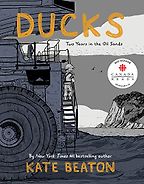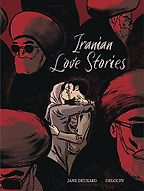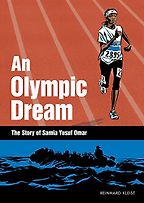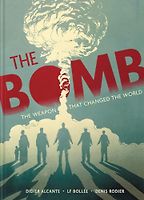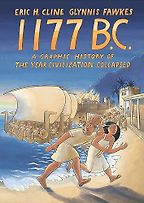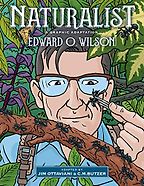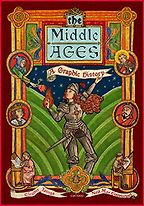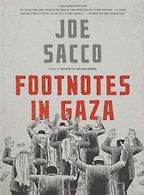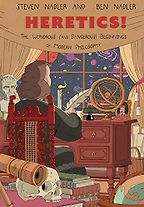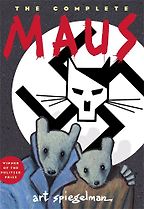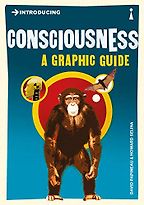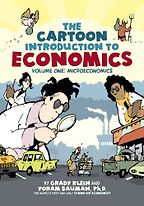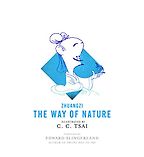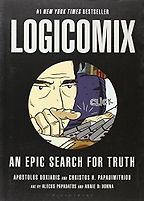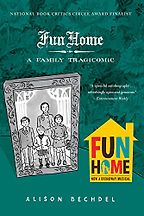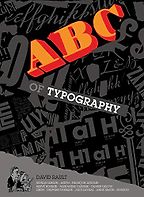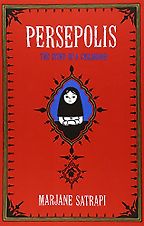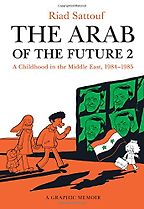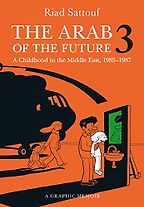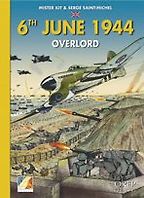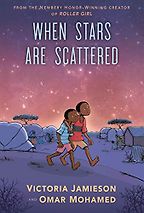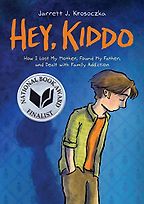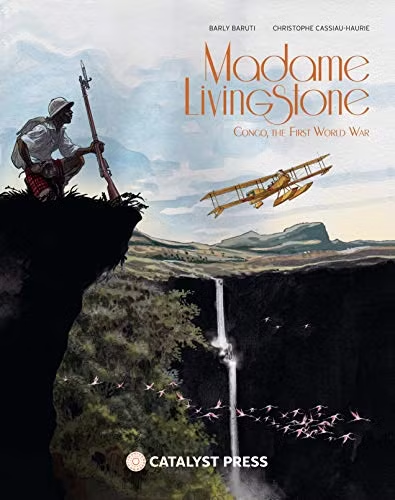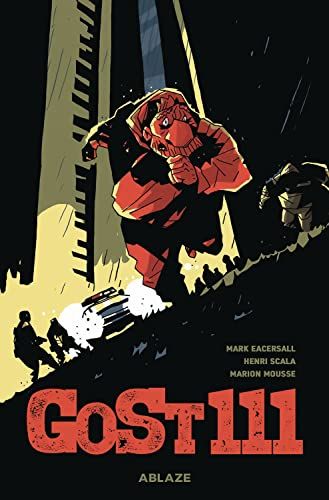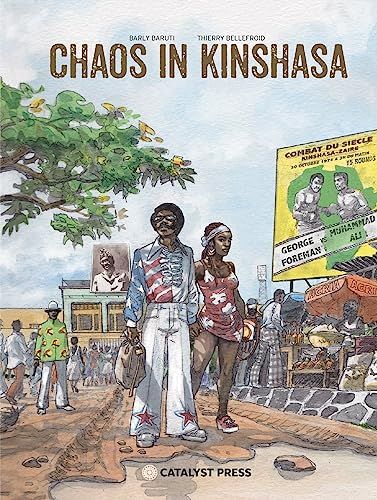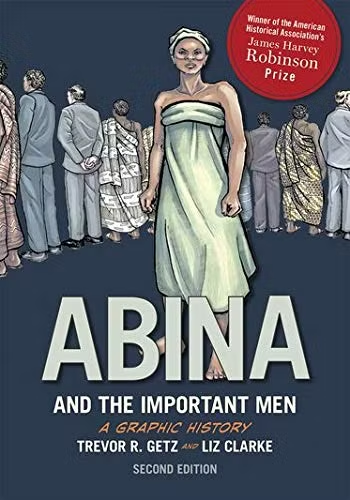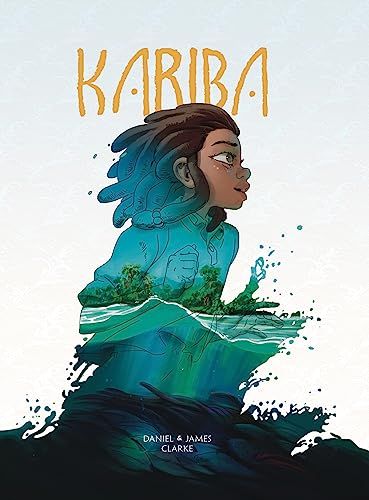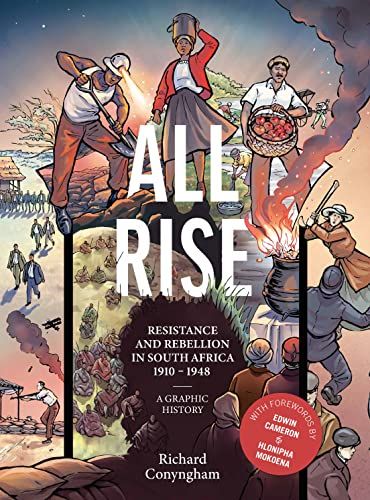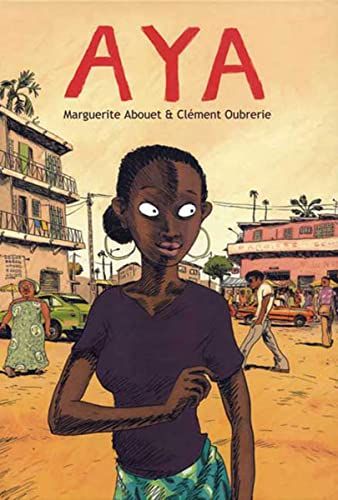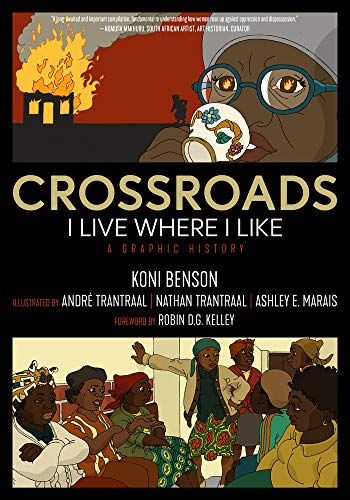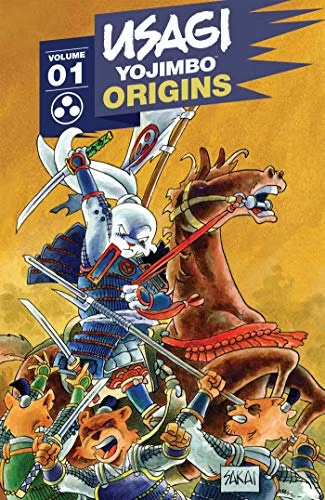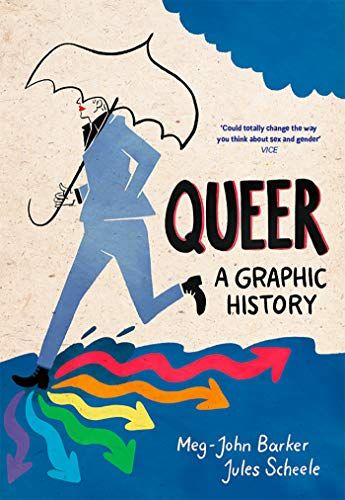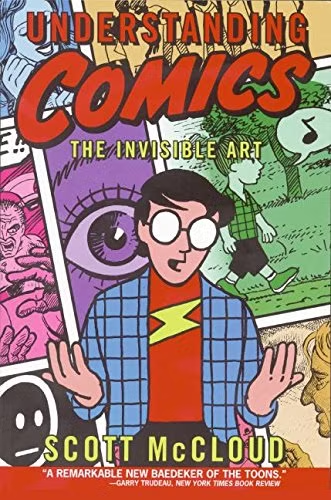Graphic Nonfiction Books
Last updated: June 24, 2025
Whether you want to read poignant memoirs or personal stories, take in the basics of economics or philosophy or Daoism, or learn more about the Middle Ages or the Middle East, graphic nonfiction (a.k.a. nonfiction comics) is a great way to go. Often dismissed as being for kids, the reality is that words and pictures, when combined, are a great way for any human being to better understand the world around them. Below we've collected together all the times a book of graphic nonfiction has been recommended by an expert on Five Books, as well as including some of our own favourites.
If you're interested in learning more about how comics work and why they should be taken seriously as a way of conveying information, Scott McCloud's book Understanding Comics is a great place to start. He also goes back in time to show how historically important comics have been for conveying information—for example through the Codex Nuttall and the Bayeux Tapestry.
Ducks: Two Years in the Oil Sands
by Kate Beaton
🏆 Winner of the 2024 Jan Michalski Prize for Literature
In this award-winning graphic memoir, creator Kate Beaton documents her time working in a modern-day oil town in Alberta, Canada—in a bid to pay off her student debts. Expect vast landscapes, colossal machinery, and culture shock amid this most male-dominated of communities. An accessible and engaging book that pairs beautifully with John Vaillant's Fire Weather, a Baillie Gifford Prize-winning account of the extreme wildfire that razed the settlement in 2016.
“These are stories of young people in Iran who can’t freely have relationships. it’s about the life of young couples in Iran. There are no public displays of affection, you can’t choose who you marry. We’re not ignorant of what’s going on in Iran, but you don’t really realize at what level things are until you read this. Also, you learn about Iranian culture. You’re not supposed to drink, but they have these elegant parties in their apartments. The life there is not free like our life. They’re not even free to love.” Read more...
Five Graphic Novels People Need to Read
Ivanka Hahnenberger, Translator
“Olympic Dream is the story of Samia Yusuf Omar. If you watched the 2008 Beijing Olympics, she was the young Somalian woman who came in last…She doesn’t have the right clothes, she doesn’t really have the right shoes. But she runs, and she doesn’t give up. Everyone in the stadium was on their feet applauding her, because she had to defy her nation and defy her culture to get to be able to run. No one left the stadium before she finished, they’re all sitting there watching her, not a dry eye in the house…Reinhard Kleist traces this whole story of hers, and her family at home: how people gave up a lot to get the money so she could be smuggled. I’m not going to tell you what happens. It’s just the incredible story of this woman. I really recommend this book. It’s extraordinary.” Read more...
Five Graphic Novels People Need to Read
Ivanka Hahnenberger, Translator
The Bomb: The Weapon That Changed the World
by Didier Alcante, Laurent-Frédéric Bollée and Denis Rodier (illustrator)
“I feel this book is really important, because it’s easier to swallow than many of the big books that we have on the history of the A-bomb…The story is really emotional when you see it in pictures. In the beginning, you see the excitement in the scientists’ faces when they discover the chain reaction. It’s an incredible thing. They go into a squash court at the University of Chicago, and it actually happens. Everybody’s shocked and amazed and excited… The way they depict Einstein and his suffering… Everybody was saying, ‘We need to have the A-bomb.’ But then, when you have it, you realize you’ve created a monster.” Read more...
Five Graphic Novels People Need to Read
Ivanka Hahnenberger, Translator
1177 BC: A Graphic History of the Year Civilization Collapsed
by Eric Cline & Glynnis Fawkes (illustrator)
1177 BC: A Graphic History of the Year Civilization Collapsed is a graphic adaptation of a 2014 book by American historian and archaeologist Eric Cline. It's a very lively and highly enjoyable way to find out what was happening and what life was like in the Aegean and Eastern Mediterranean in the Late Bronze Age. It covers the 15th to the 12th centuries BC and shows us both what we know about it, and how we know it (Egyptian steles play a big part). Also out in April, 2024, is After 1177BC, a follow-up book subtitled The Survival of Civilizations, about what happened after the Bronze Age collapse chronicled in 1177BC.
Naturalist: A Graphic Adaptation
by C.M.Butzer, Edward O. Wilson & Jim Ottaviani
This book is a wonderful graphic adaptation of biologist EO Wilson's memoirs. It's touching and enlightening and leaves you feeling excited about the natural world. It's also interesting for the light it sheds on what makes someone a great scientist. Wilson, born in 1929, won two Pulitzer Prizes for nonfiction for his books, one in 1979 for On Human Nature, and one in 1991 for The Ants, co-authored with German biologist Bert Hölldobler. EO Wilson's books—he wrote many—have also been frequently recommended on Five Books.
The Middle Ages: A Graphic History
Eleanor Janega and Neil Max Emmanuel (illustrator)
The Middle Ages: A Graphic History is by Eleanor Janega, a medieval historian who teaches at a number of London universities and blogs at going-medieval.com and Neil Emmanuel, an illustrator who also worked on Time Team, Britain’s longest-running historical TV show. It's a lovely breeze through a millennium of history, focusing mainly on Europe and the Near East (according to the book, the medieval period in China ended in 960, which means China became 'modern' about 600 years before Europe did). It's a lot of fun and you learn a lot in a couple of hours.
“This is an amazing, graphic and emotional book. Sacco writes about the massacres carried out by the Israeli army in the Gaza Strip in 1956. He completed the book in 2003 so it resonates with the present. It’s really about memory: how it can fool you and change things. He sifts through the memories of the witnesses he meets in Gaza to get to the truth of the two atrocities – one in Rafah, the other in Khan Younis.” Read more...
Raja Shehadeh, Lawyer
“One of the brilliant things about Tom Toles’s cartoons is that he…makes people realise how really crazy some of the things that climate change deniers say are and how crazy some of the things they do are. I could go on for hours lecturing about some of these things but with Tom Toles’s cartoons you get it in an instant.” Read more...
The best books on The Politics of Climate Change
Naomi Oreskes, Scientist
“It’s a wonderful look both biographically and artistically and scientifically at Marie and Pierre Curie, although Pierre dies about halfway through the book because he was run over by a horse carriage and killed. It talks at length about Marie Curie’s affair, after Pierre’s death, with Pierre’s student Paul Langevin and the impact that had. You can imagine in the early 20th century it wasn’t easy. The book really does blend the scientific and the personal very, very beautifully…It’s graphic nonfiction.” Read more...
Richard Wolfson, Scientist
Heretics! The Wondrous (and Dangerous) Beginnings of Modern Philosophy
by Ben Nadler (illustrator) & Steven Nadler
In Heretics! Steven Nadler, an American philosopher who is one of the leading experts on the early modern period (we interviewed him about the best books on Spinoza), teams up with his son Ben Nadler, an illustrator, to bring us a brilliant account of 17th century natural philosophy (a.k.a. the Scientific Revolution). It's an incredibly challenging topic, partly because these scientists and philosophers were partly wrong and partly right, and their world view so different from ours. The stakes were also very, very high, and the book starts with someone being burnt at the stake.
“If I have a preferred book to read about the Holocaust, it’s probably the graphic novel Maus by Art Spiegelman, about his parents’ experience in Poland. Many have read it, but if you haven’t, you must. It’s set in late 1970s New York, and is as much about the son’s relationship with the father who went through all this, as it is about the events of the 1930s and 40s in Poland.” Read more...
Sophie Roell, Journalist
“It’s part of the Introducing… series that presents various topics in graphic form, a bit like a comic book. What I liked about this one is that it takes a very complex issue and shows that you do not need to be a great philosopher, or have a very deep understanding of the science, to understand why it’s a complex issue and what the fundamental questions we’re dealing with are…Despite being highly approachable, this book is a serious piece of work that gives a great overview of past and current thinking about consciousness, especially from the philosophical perspective.” Read more...
Consciousness for Beginners: the best book
David Carmel, Psychologist
“This is by Yoram Bauman, who is perhaps better known as the stand-up economist. He sprang to fame because of this lecture – you can see it on YouTube – which was a stand-up comedy routine, based on a parody of one of the most famous economics textbooks, Greg Mankiw’s Principles of Economics. Bauman has a PhD in economics, so he knows a lot of economics, and there’s actually quite a lot of wisdom woven into the comedy routine, but he just lays into economics. Then he decided that the next thing he wanted to do was write this cartoon introduction to economics. And, just to be clear, this is a textbook. It’s not a comic book with some economic messages, it’s a textbook in the form of a cartoon. But it’s quite sophisticated and it’s very nicely done…For anybody who is genuinely interested in economics, who really wants to learn the jargon, or anyone who is starting out studying an economics course, this is just a brilliant source. It really is rigorous, but it’s also a lot of fun to read.” Read more...
Tim Harford, Economist
The Way of Nature (The Illustrated Library of Chinese Classics)
by Zhuangzi (aka Chuang Tzu), C. C. Tsai (illustrator) and Brian Bruya (translator)
“Now you have more and more Westerners who are interested in this kind of philosophy and doing philosophy globally. But there is a sense in which Zhuangzi is profound, but also funny and light-hearted. There are a lot of really silly moments, almost. And I think that this version of Zhuangzi—and I have three different versions—is the only one that really captures this playfulness, helps to remind you, when you’re reading it, that, ‘Okay, this is a serious philosophical text, but it’s also a silly and playful philosophical text.’ I think that this format does that very well.” Read more...
The Best Illustrated Philosophy Books
Helen De Cruz, Philosopher
“The story starts with a lecture by Bertrand Russell. You have Russell standing there on the podium and he starts his lecture by saying, ‘Okay we’re now in this situation, should we fight against the Nazis? Yes, or no?’ It’s 1939, and there is this whole thing in the UK, should they or shouldn’t they? Should they be trying to keep the peace with the Nazis? And that didn’t go very well, it didn’t last very long. Russell was a pacifist and the audience knew that. And he says, ‘Well, before we do that we have to think about the rules of thoughts, to make such a decision.’ And then you go back in the past, and you see Russell and the people around him.” Read more...
The Best Illustrated Philosophy Books
Helen De Cruz, Philosopher
“‘Fun Home’ is short for the funeral home Alison’s dad ran when she was a child. It’s a book that blew me away and continues to blow me away every time I read it – and I must have read it five or six times by now: probably the best book I’ve read in the past ten years in any genre or form. It’s an incredibly crafted book in which the chapters are not chronological but thematic, and each chapter is keyed to a book that her father loved. So it’s not a book about what happened to her father, a closeted gay man who committed suicide a few months after Alison herself came out when she was 19. It’s about looking through a family archive to try and get a sense of her father’s particularity.” Read more...
Hillary Chute, Literary Scholar
“Eleven artists, eleven chapters from cuneiform to Comic Sans, the whole thing is lent a gorgeous graphic identity by none other than the cantankerous, radical underground cartoonist and diehard indie Jean-Christophe Menu. As a founding member of L’Association, he masterminded their selection and design of forgotten classics brought back into print. Together, they’ve created a bristling yet unified history of a ubiquitous yet somehow still niche subject. Serifs, frakturs, Gutenberg, Garamond, Gill Sans, Bauhaus, newspapers and Letraset.” Read more...
The Best European Graphic Novels
Edward Gauvin, Translator
“It really gets into the feel of what it was like then, throughout the Islamic revolution and the Iran-Iraq war. It shows the history of Iran through one person’s life, and the people around her. The author’s family wanted the revolution, which was when the people in Iran revolted against the monarch. Her grandfather was a prince, but he became a communist. They were a pretty well-off family, but they still wanted the Shah to leave. The Shah wasn’t doing a good job of ruling, and I think most people wanted that to change. But they had no idea that Iran would become even more oppressive than before, after becoming an Islamic republic. This graphic novel describes how it got worse and how horrible it was.” Read more...
The Best Graphic Novels for 10-12 Year Olds
Harald, Children
“This series has been a cultural and a publishing phenomenon in France and I think now it is starting to be in the US too…It’s similar in some ways—and radically different in others—to Persepolis by Marjane Satrapi. Both are a view of conflict in the Middle East. Persepolis is about the Iran-Iraq war, the Islamic Revolution, and a right-wing, Islamic viewpoint, which The Arab of the Future also deals with, in part. Both have a child at the centre of the story. The child anchors the narrative, and we see events unfolding in a chronological, linear way from the point of view of the child. That was something that Persepolis established as a really compelling form. The Arab of the Future has echoes of that.” Read more...
Hillary Chute, Literary Scholar
“This book shows how political the personal is, if it makes any sense to invert that idiom. It balances attention to the world historical stage with attention to what is happening within this family.” Read more...
Hillary Chute, Literary Scholar
6th June 1944: Overlord
by Master Kit & Serge Saint-Michel
6th June 1944: Overlord is a great graphic narrative about D-Day and the landings on the Normandy beaches. It opens in April 1944 with the run-up and preparation for Operation Overlord and goes right through to the liberation of Paris on August 25th, 1944. It shows you what was going on on the different beaches (Utah, Omaha, Gold, Juno, Sword and Pointe du Hoc), and follows different stories. There are maps and nice details, like the German commanders delaying and losing vital hours because they didn’t want to wake up Hitler, who was a notorious late riser.
As the cover advertises (in our edition) it’s ‘the entire history of the D-Day landings in just 82 pages.’
When Stars Are Scattered
by Omar Mohamed and Victoria Jamieson, narrated by Faysal Ahmed (and full cast)
***American Library Association Amazing Audiobook for Young Adults 2021***
“It’s inspired by a refugee from Somalia, Omar Mohamed, who is one of the co-authors. It’s roughly the story of him growing up in a refugee camp in Kenya and trying to get to safety in America. It’s about spending so many years there, waiting.” Read more...
The Best Audiobooks for Kids of 2020
Emily Connelly, Journalist
Hey, Kiddo
by Jarrett Krosoczka
🏆 2020 Odyssey Award: Best Audiobook for Young Adults
🏆 2020 Audie Awards Best Audiobook for Young Adults
Hey Kiddo is a graphic memoir so you’d think it would be hard to turn into an audiobook. Instead, it’s won two major audiobook awards. The author, Jarrett Krosoczka, narrates the story himself, with a cast that includes actors but also some family members.
Narrator: Jarrett J. Krosoczka, Jeanne Birdsall, Richard Ferrone, Jenna Lamia
Length: 2 hours and 50 minutes
“Hey, Kiddo was a National Book Award finalist as a graphic memoir, recognising the literary power of Krosoczka’s personal story of his mother’s heroin addiction and childhood with alcoholic grandparents. It’s told from the point of view of Krosoczka at age 17, and teens forge an immediate connection with the author’s description of how his artistic talent helped him survive his upbringing.” Read more...
“It’s great because you don’t really know if it’s fiction or fact. This man claims to be David Livingstone’s son. I guess it is supposed to be true. It’s set in the Belgian Congo in the First World War. He’s a Belgian pilot’s local guide but, at the same time, he’s saying, ‘I’m one of you’ and wears a kilt. It’s just really cool.” Read more...
Five Graphic Novels People Need to Read
Ivanka Hahnenberger, Translator
“GoSt 111 is one of my sweetheart books…It’s really fun because it shows you a piece of Paris, and life in general, that you don’t know. It’s about underground life and how it’s a struggle. This guy is a Serb and no matter what he does, he seems to get involved in thuggery instead of getting on the straight and narrow. He’s got a little girl, and his mother, her grandmother, is helping out. He gets out of jail and tries to avoid it, but once again, he gets drawn in. He always seems to get drawn down the wrong path. It’s fiction, but it could be true, just not being able to get out.” Read more...
Five Graphic Novels People Need to Read
Ivanka Hahnenberger, Translator
“Chaos in Kinshasa is one of my favorites. Partly it’s because I remember the whole Rumble in the Jungle story happening — I’m that old! I was in Philly, where I remember seeing Cassius Clay’s name, his switch to Muhamed Ali, and then he was going over there, to Kinshasa. Being Black in Africa is different from being Black in America—it’s not the same culture at all. I remember it was quite eye opening for a lot of people, whites and Blacks alike.And then to read this story! I never knew about all the political intrigue that was going on at the time and that it was a pawn in a political game. I was too young to get that—all the African politics, how Angola was involved. It’s amazing that these authors managed to get all that into this book and at the same time make it fun and funny. It’s really great. I totally recommend it. If you didn’t have any idea of the intrigue and politics behind the Rumble in the Jungle, you have to read this.” Read more...
Five Graphic Novels People Need to Read
Ivanka Hahnenberger, Translator
Abina and the Important Men: A Graphic History
Trevor Getz and Liz Clarke (illustrator)
“I read a court case where a young African woman, Abina Mansah, who didn’t speak English, went before a British judge and complained that she had been enslaved. She said, ‘I could not take care of my body and myself.’ I wanted to know what she meant and what her experiences were. I followed that for many years, trying to understand what was going on. In my classroom, I wanted students to understand how historians struggle to hear the voices of people like her and what tools we can have to do that. It suddenly occurred to me that the way I could do that best was to give students my interpretation of her words in comic form, and then to give students the tools to question or come up with their own interpretations of what it meant. That’s what my comic book is. More than anything, it’s a teaching tool. It’s an attempt to help the students understand why we should listen for these voices and how we can do that.” Read more...
The Best Comics on African History
Trevor Getz, Historian
“You don’t see many stories set in Zimbabwe, which made this graphic novel a bit different for me. The art is nice and colourful and depicts the nature of southern Africa really well. The characters are well written and it’s a good story. I like it. The main character, Siku… has to make a decision and face her powers and stop the river god getting killed. So she goes on a big adventure with some pirates and an Italian boy whose mum is an engineer working to build the dam. The Kariba dam really exists on the Zambesi river. It was built in the 1950s so the story is set then, although it is fantasy. It’s about having to make a choice between the environment and development, or whether there is a way to find a balance. This book has quite a lot of pages, I think it’s best for 10-13 year olds.” Read more...
The Best Graphic Novels for 10-12 Year Olds
Harald, Children
“Conyngham is the mover behind this book, but he found a whole bunch of different South African artists to do the art. It’s a collaboration. Although there is coherence across the chapters, you have some very different kinds of art, which is quite interesting. It’s about resistance and rebellion in South Africa, but it takes place almost entirely before apartheid (though the last chapter does go into the apartheid era). It’s a book that comes out of the archives of South Africa’s Supreme Court of Appeal. At the end of apartheid, the new government built this incredible Supreme Court, with an archive, to provide a beacon of law, if you will, for across the continent. You can go there, it’s open. Richard Conyngham looked in this archive and pulled out all these stories about resistance and rebellion. They’re not all about race. Some are about class and labor, which may be surprising to some people. But before 1948, that’s appropriate, because class mattered as well. They are sketches of stories of the people who make up South Africa. It’s about Indian resistance to being forced to register. It’s about mine workers who are on strike because of horrible conditions in the mines. It’s about the way that colonialism appointed these state-controlled chiefs, and the way people revolted against these chiefs acting as stooges to control their movement and labor.” Read more...
The Best Comics on African History
Trevor Getz, Historian
“Aya and her friends grow up in a big city. Côte D’Ivoire was pretty wealthy at the time, at least in the urban areas. But the main character in this story are working class. They go out, they go to dances. One of them gets pregnant. It’s an incredible imagining of these things. When Marguerite Abouet wanted to write about her life, she was really inspired by Marjane Satrapi’s Persepolis, which is perhaps the best-known classroom-friendly graphic history of all (even more so than Art Spiegelman’s Maus, which is getting banned in the US now). Although Marjane Satrapi comes from Iran, she was living in France, and she created a very French-style comic.” Read more...
The Best Comics on African History
Trevor Getz, Historian
Crossroads: I Live Where I Like
Koni Benson, André & Nathan Trantraal (Illustrators), Ashley Marais (Illustrator)
“The story told in Crossroads is not about their suffering, per se. It’s the story of their resistance, told in their own words. It’s a history of an informal community that wasn’t allowed to exist and the women who successively resisted attempts to dismantle it, force everyone to move, and bring it into line. Koni worked closely with the local community to pull out their experiences while these women are still alive. The things they went through are horrible, but the ways in which they fought back—putting on plays, grabbing sticks and beating police informers and such—are amazing.” Read more...
The Best Comics on African History
Trevor Getz, Historian
“It’s based on Miyamoto Musashi, who was a very well-known swordsman in the Edo period. The beautiful thing is that Stan Sakai, who wrote it, his family were Japanese immigrants to America. It was his way of connecting to their culture, to tell stories that don’t get told in America. One way of doing it is to throw an anthropomorphic animal at it, so that people are willing to listen. It’s a brilliant move, because if he had just gone, ‘Here we go, I’m doing Edo period samurai’ you would have had a lot less uptake. There is something about using animals that brings people in.” Read more...
Queer: A Graphic History
by Meg-John Barker and Jules Scheele (illustrator)
“Queer: A Graphic History is incredible. It does a great job of breaking down a complex narrative and showing what you can do with pictures. This book is how I got the idea to do my own. I was walking along a canal in Oxford with friends talking about how great it was, and how it’s a really effective format for explaining ideas like this, and my husband said, ‘why don’t you do one?’ I thought, ‘that’s a great question. Why don’t I?’ So this is the graphic history that got me to do a graphic history very directly.” Read more...
“It’s like enriched uranium in comic form—non-radioactive, good stuff, full of energy. I read it when it came out, I was at art school. It really did shape the way that I went forward and thought about sequential imagery. I still use it to this day, when teaching storyboarding. It’s about telling stories, all that stuff. It also gives you some comic theory, all distilled into one little book that you can just read, and then feel like, ‘I’ve got a PhD in understanding comics.’” Read more...
-

1
The Bomb: The Weapon That Changed the World
by Didier Alcante, Laurent-Frédéric Bollée and Denis Rodier (illustrator) -

2
An Olympic Dream: The Story of Samia Yusuf Omar
by Reinhard Kleist -

3
Iranian Love Stories
by Jane Deuxard and Deloupy (illustrator) -

4
Chaos in Kinshasa
by Barly Baruti (illustrator) & Thierry Bellefroid -

5
GoSt 111
by Henri Scala, Marion Mousse (illustrator) & Mark Eacersall
Five Graphic Novels People Need to Read, recommended by Ivanka Hahnenberger
Five Graphic Novels People Need to Read, recommended by Ivanka Hahnenberger
Comics are a great way to read all sorts of stories, whether fiction, nonfiction, or a compelling blend of the two. Ivanka Hahnenberger, translator of more than 70 graphic novels, talks us through some of her favourites, from the history of the atomic bomb to the heartbreaking story of Olympic athlete Samia Yusuf Oman, from the ‘Rumble in the Jungle’ to contemporary Iran and Paris.
-

1
Crossroads: I Live Where I Like
Koni Benson, André & Nathan Trantraal (Illustrators), Ashley Marais (Illustrator) -

2
Aya
Marguerite Abouet and Clément Oubrerie (illustrator) -

3
All Rise: Resistance and Rebellion in South Africa
by Richard Conyngham (editor) -

4
Madame Livingstone: The Great War in the Congo
by Barly Baruti (illustrator) & Christophe Cassiau-Haurie -

5
Kariba
by Daniel Clarke, Daniel Snaddon & James Clarke
The Best Comics on African History, recommended by Trevor Getz
The Best Comics on African History, recommended by Trevor Getz
Graphic narratives can be a great way to learn history but they need to be both good history and good comics. That’s a combination that can be hard to find. Trevor Getz, a professor of history at San Francisco State University, picks out his top comic books on African history.
Best Graphic Histories, recommended by Eleanor Janega & Neil Emmanuel
Graphic histories can offer complex and layered insights into the past and are underused as a medium, argue historian Eleanor Janega and illustrator Neil Emmanuel, authors of The Middle Ages: A Graphic History. Here, they recommend five graphic histories that show the power of comics not only for telling moving stories but also transmitting difficult concepts.
